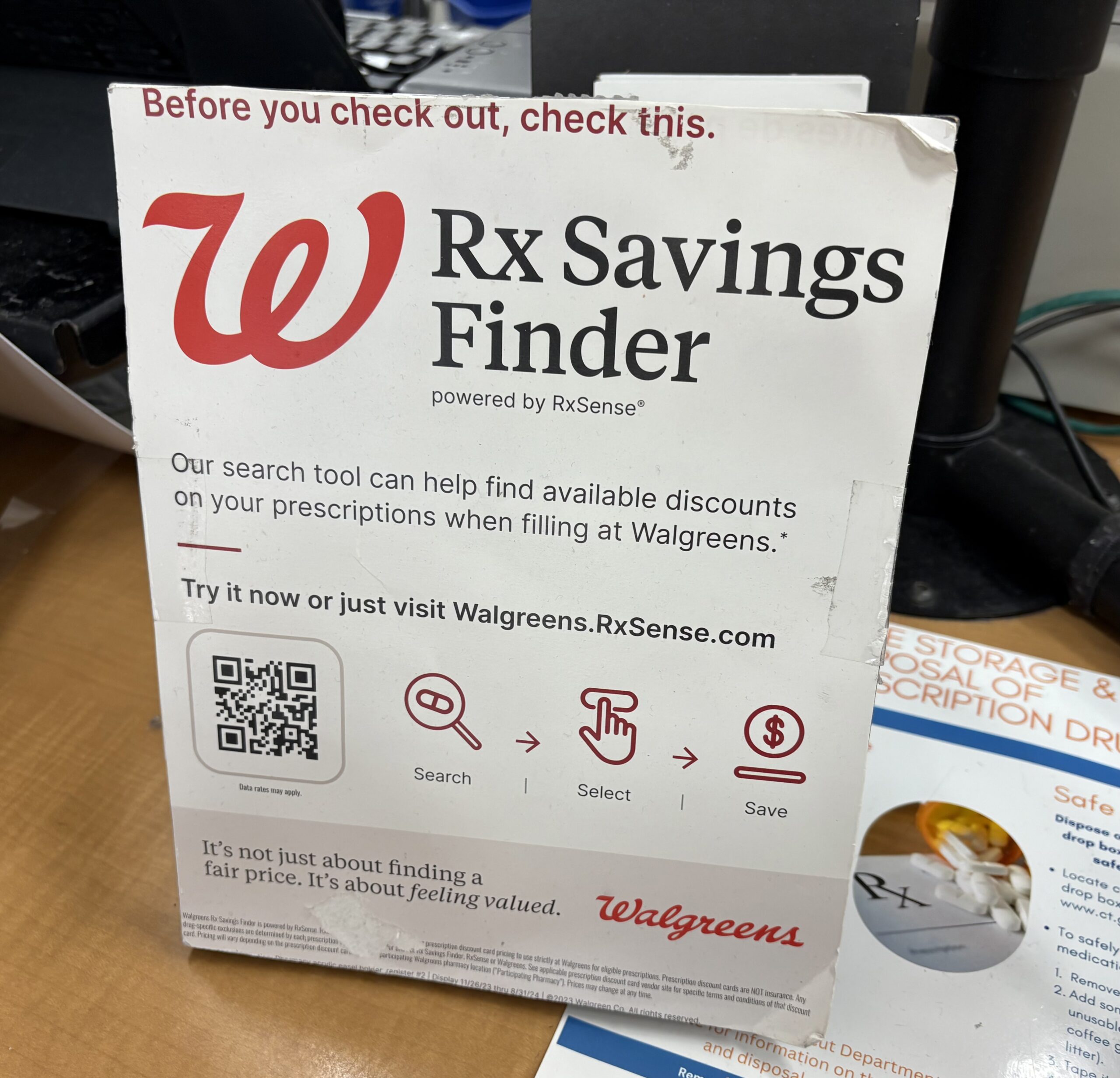From the West Hartford Archives: Superior Food and Stoughton Drugs on Farmington Avenue

Audio By Carbonatix

774 Farmington Avenue. Courtesy of Noah Webster House & West Hartford Historical Society
Historian Jeff Murray takes a look into West Hartford’s past to uncover some surprising information, stir up some memories, or reflect on how much life has changed – or hasn’t changed at all. Enjoy this week’s ‘From West Hartford’s Archives’ …
By Jeff Murray
The stores of Superior Food and Stoughton Drugs were at 774 Farmington Avenue when this photo was taken in the mid-1960s. Built in 1933, the building that housed these stores is actually the youngest in the neighborhood on the north side of the road. The oldest, a colonial home refashioned over the years into a commercial space, is right next door at 776 Farmington Avenue.
From the early 1800s, the land at the northeast corner of Quaker Lane and Farmington Avenue was in the possession of the Gilbert family, a prominent Quaker clan that came to town early in its history. One of its members, Erastus Gilbert, was a Hartford grocer who owned a house on the corner, rented out over the years.
This property extended from North Quaker Lane to the current West Hill Drive. The land east of this all the way to the Hartford line was owned by the sons of Paul Hamilton, Alexander and Benedict, who inherited it all when he died in 1851. Benedict Hamilton’s daughter married William Hall, the principal of the first high school and superintendent of schools in West Hartford, so he had much to talk about many decades later when writing the first comprehensive history of the town.
The house that the Hamiltons lived in was a colonial-era house known as the Perkins house. It was built by Dr. Nathan Perkins, who was pastor of the Congregational Church during the American Revolution, for his lawyer son. Standing where West Hill Drive is today, the Hamiltons sold it in the 1850s to the “Commodore” Cornelius Vanderbilt, famous railroad tycoon and one of the wealthiest Americans in history. The house was occupied by the Commodore’s son, Cornelius Jeremiah, until his wife died in the early 1870s, at which point the Vanderbilts sold it back to the Hamiltons.
Now back in their possession, they looked to continue laying out the area east to Prospect Avenue. They ultimately set the course of development for the future Highland and Concord Streets. Alexander Hamilton also laid out Hamilton Avenue through the property and sold the old Perkins house to Erastus Gilbert, who physically moved the house onto his property, slightly west of where Whiting Lane connects with Farmington Avenue. The younger Cornelius Vanderbilt would eventually buy the property in the late 1870s to build the famous Vanderbilt Mansion on the site of the old house; however, he never occupied it and took his own life at the Glenham Hotel in New York City, allegedly after a night at a gambling house in April 1882.
In the early 1900s, the heirs of the Gilbert estate sold a chunk of land along Farmington Avenue, about one lot in depth, excluding the old Perkins house, to Edwin Arnold and his son Frederick W. Arnold, founders and proprietors of the Trout Brook Ice Company down the road.
Far back from the street, surrounded by grass meadows, the Perkins house and estate, owned now by Erastus Gilbert’s daughter and son-in-law John W. Titcomb, was rented to three black families for 18 years – those of Cephas Grant, Josephus Grant, and Isaac C. Tunstall. All three were born in Virginia just before or just after the Civil War and came to Connecticut as adults.
Big cities tended to be the destination for blacks moving north from the South after the Civil War, but growth in the outlying towns was just as significant. In fact, based on census records, most migration during this period was from Virginia, South Carolina, and Georgia. Cephas Grant oversaw the Gilbert estate and would eventually accumulate enough wealth over the years to own a house on South Quaker Lane until losing it all during the Great Depression. Josephus Grant was a coachman, and Isaac Tunstall was employed as a farm laborer on the estate. In the year 1900, across the three families, the house was occupied by 13 people, including six children, all under the age of 10.
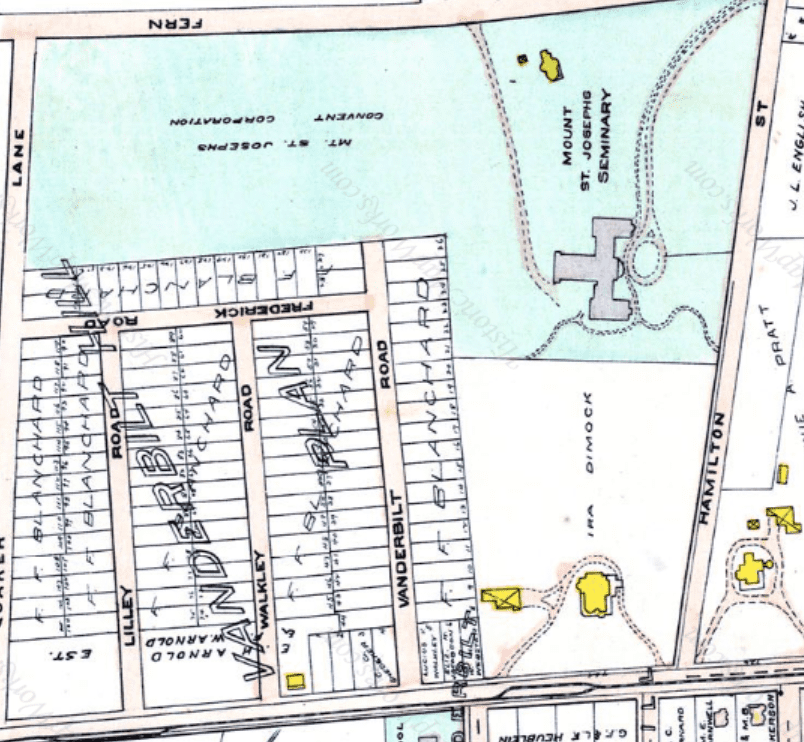
Map of the area in 1909 – the Perkins house can be seen at the corner of Walkley Road after it was moved.
Shortly after John Titcomb’s death in December 1908, his wife Delia Gilbert was approached by Dr. Charles E. Morris, who convinced her to sell the whole Gilbert estate and invest the money, which would turn a great profit if he could manage it. Within just a few months, the whole property was sold to a real estate syndicate out of Boston under Fred F. Blanchard, who laid out Lilley Road, Walkley Road, Vanderbilt Road, and Frederick Road in this Vanderbilt Hill subdivision.
One of the roads ran right through the path of the Perkins house, so Blanchard sold it to Frederick Arnold, who renovated the place after it had been out of occupation for some time. He then propped it up and moved it (for a second time in its history) to its current position at 776 Farmington Avenue at the corner of Walkley Road in the summer of 1909.
What followed was a bonanza of real estate investment by Hartford buyers and house building. Some of the first houses in the subdivision, notably on Vanderbilt Road, were by Jewish residents coming from Hartford, like Max Myers (who was later instrumental in the construction of the synagogue down the road). Some speculators bought up ten or more lots at a time to sell at their own discretion to homeowners.
As for Delia Gilbert Titcomb, who sold the property to begin with, the question remains: did she actually make a lot of money from investing it all? Unfortunately, no. In 1914, she sued Dr. Morris for $65,000 (the equivalent of $2 million today) for swindling her and for essentially stealing it all, only paying her a measly amount over a few years. That fall, a judge ruled that the money was invested legally (even if it did not work out), so she had no claim and it was dismissed.
How different would this area be if Dr. Morris hadn’t called on her right after her husband died and made such a convincing case for selling it all?
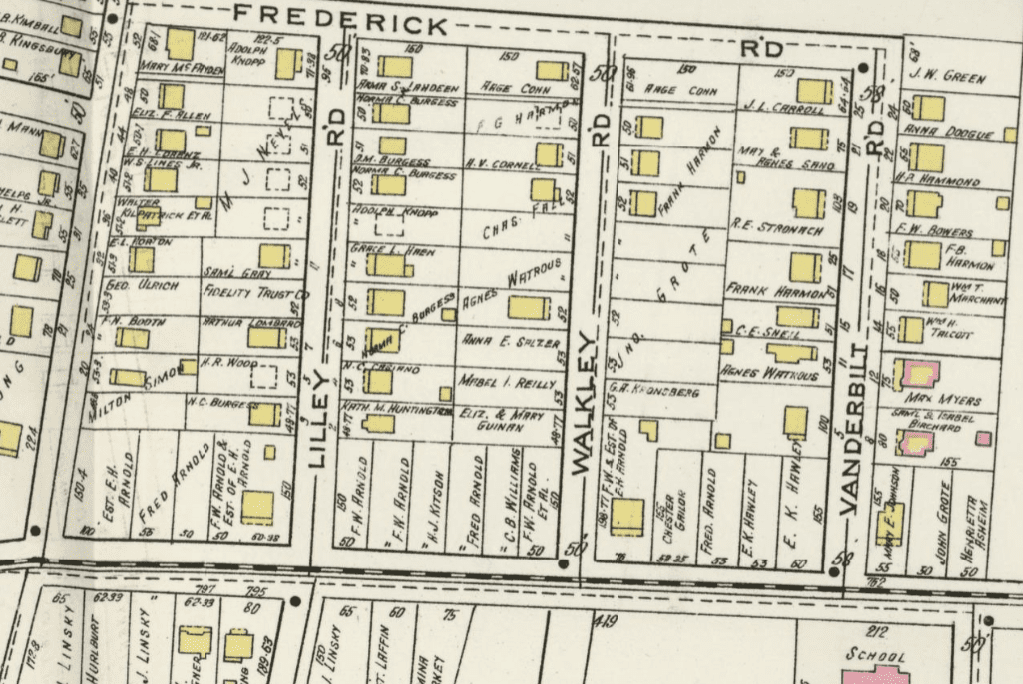
Map of the neighborhood in 1917 – the houses built or under construction in just 8 years is staggering.
At the end of 1932, the entire neighborhood had been built up, except for the lot next to the Perkins house at 774 Farmington Avenue, still owned by the Arnolds who had bought the land fronting on Farmington Avenue in the early 1900s. That December, Fannie Rattner, who purchased the lot from Frederick W. Arnold, had a one-story store building erected on the site from the plans of George Zunner, one of the most prolific architects in the area. Born in Germany, Zunner’s first work was supervisor of construction of the German buildings at the 1893 Chicago World’s Fair. He came to Hartford in 1896 and worked on the Pilgard Building, the Broadview Community Church, and several other church and bank buildings in the state.
When the building at 774 Farmington Avenue was completed in 1933, the original tenants were Stoughton Drug and First National Stores grocery. In March 1948, the Superior Food Stores market opened in the space of the First National and was originally run by Herman “Hy” Siegel as owner and meat manager and Jack Blum as grocery manager. Hy and his wife Faye Rosenthal owned the business for 37 years.
In 1965, about a year before this photo was taken, the staff consisted of Hy and Faye Siegel, Paul Quintin, Steve Memeth, Lee Biron, and Ralph Porter. It continued as a grocery store and market after it was sold in the 1980s and was renovated in 1995. According to the Hartford Courant, the interior renovation and expansion of the inventory was meant to look more like an Eastern European market to better serve the tastes of the area’s growing Russian population, with some products featuring pictures of Mikhail Gorbachev.
The Delicacy Market, now Delicacy Catering, which opened about a quarter of a century ago, is still at that location and continued the European tradition.
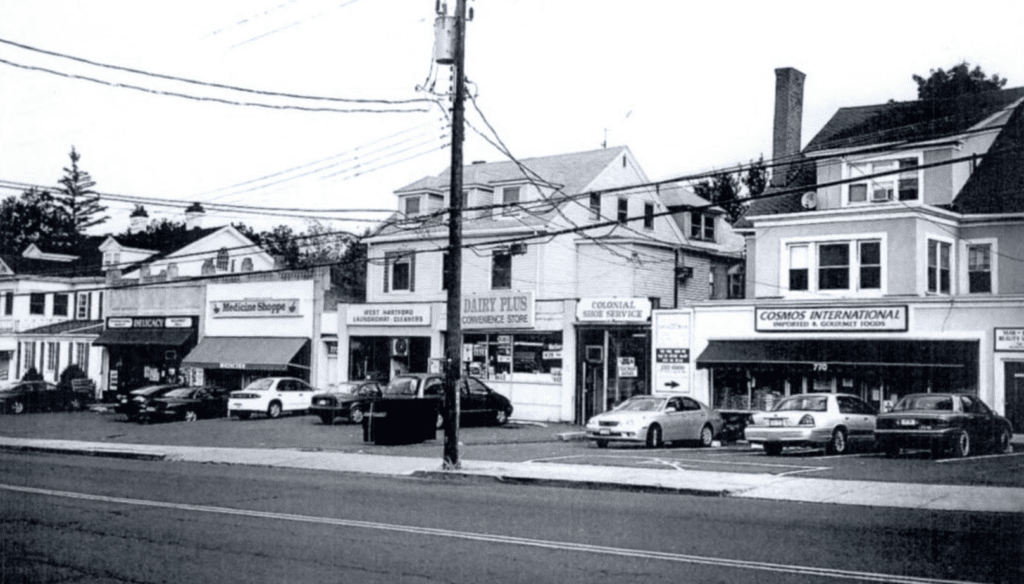
A view of the block 20 years ago, including the Delicacy Market and Medicine Shoppe at the far left. Noah Webster House & West Hartford Historical Society
Stoughton Drugs, one of the original tenants, was next door until the 1970s. The company originally started in Hartford at the corner of State Street and Front Street in 1875. The business grew over time and several other locations opened around the area, including this West Hartford location in 1933. In 1958, the store underwent a large remodel and the electric sign out front was installed. The Stoco Drug Company operated the pharmacy in the 1970s, followed by the Apothecary Prescription Centre from 1980 to June of 1991 when the current Medicine Shoppe opened.
It is surprising how aligned the businesses were from their beginnings to now, engaging in the same industries but under different owners and managers. Many people have fond memories of the businesses in the featured photo, but it wouldn’t have been possible without the decisions made in past years, even if it meant selling the hundred-year-old family farm on the advice of a lone investor.
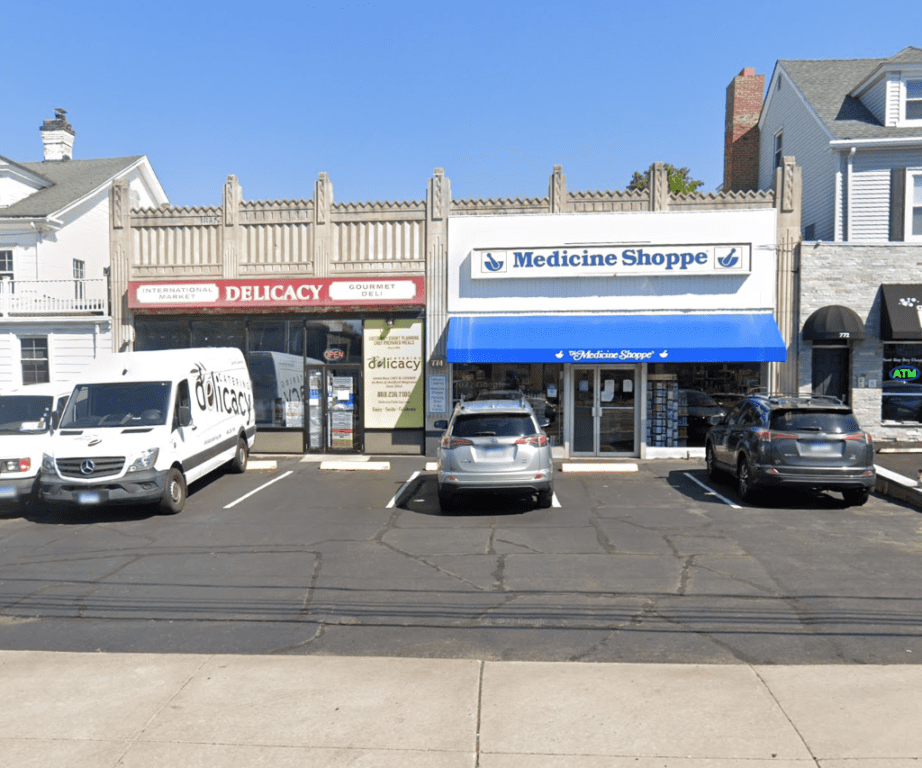
774 Farmington Avenue. Google Street View
Jeff Murray was born and raised in West Hartford and has been involved with the Noah Webster House & West Hartford Historical Society since 2011 when he was a high school student and won the Meyer Prize for his essay on local history. Jeff routinely volunteers as local history researcher uncovering information for numerous museum programs such as the West Hartford House Tour and West Hartford Hauntings. Jeff works as a data analyst at Pratt & Whitney.
Like what you see here? Click here to subscribe to We-Ha’s newsletter so you’ll always be in the know about what’s happening in West Hartford! Click the blue button below to become a supporter of We-Ha.com and our efforts to continue producing quality journalism.



